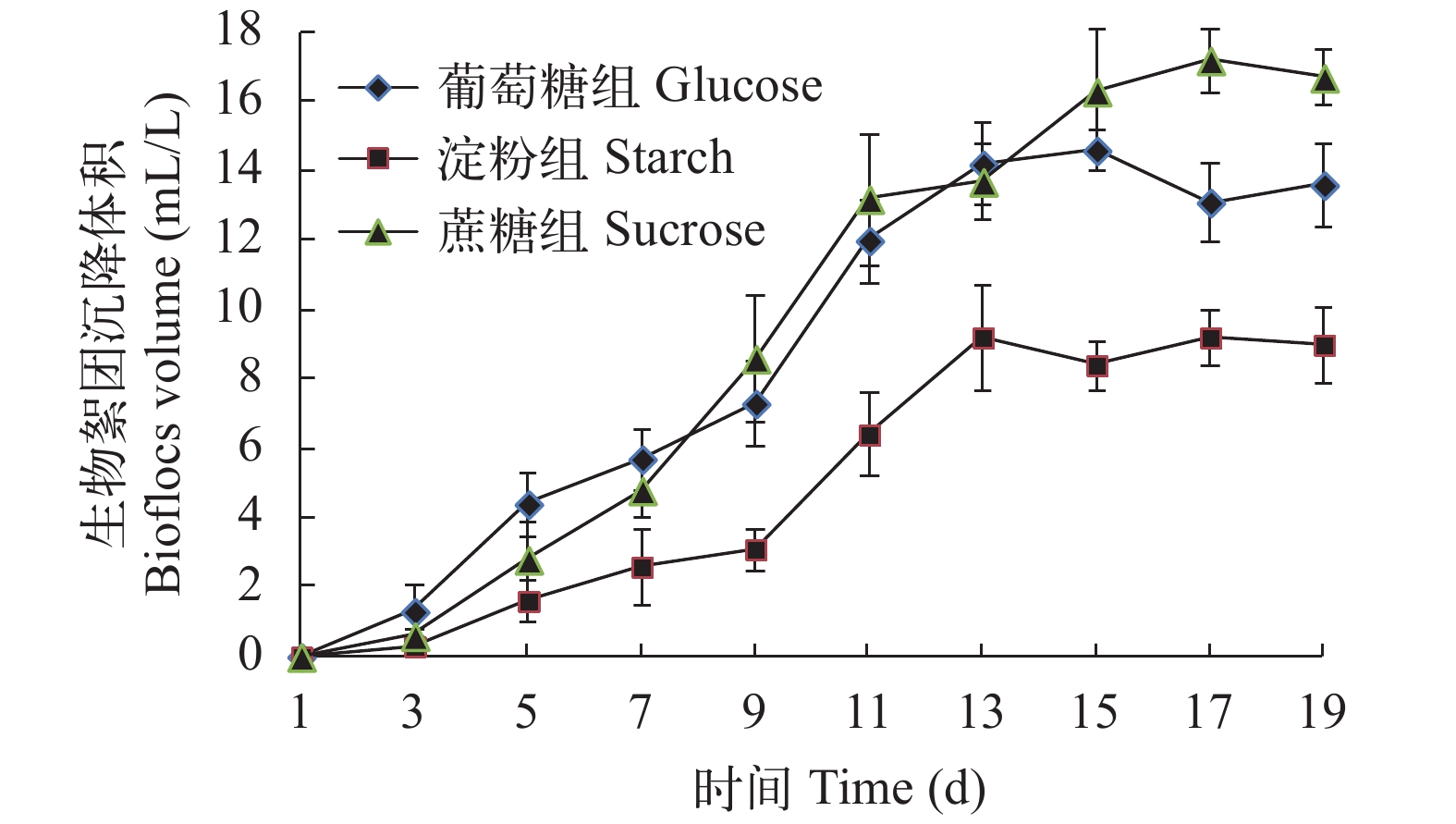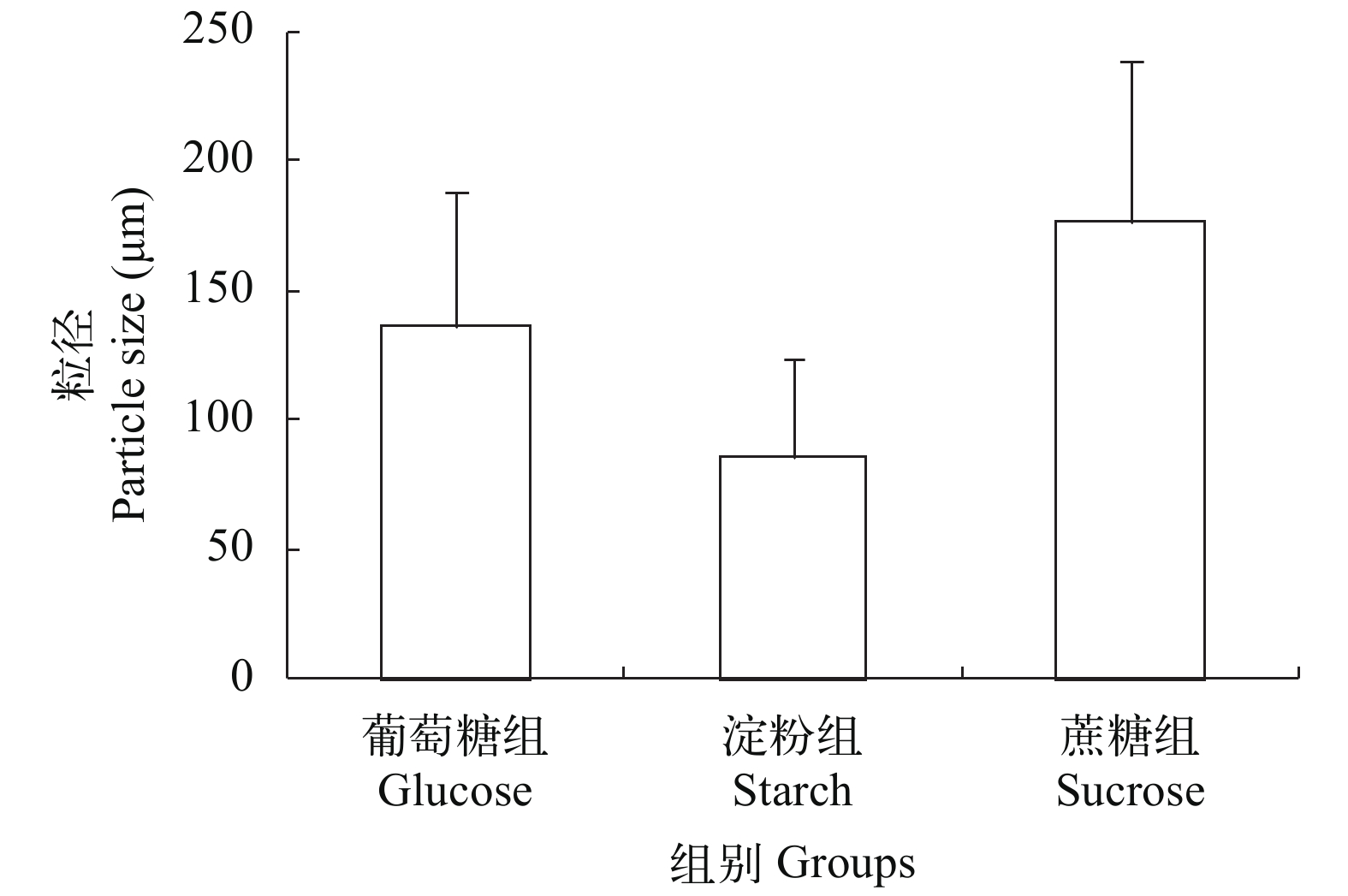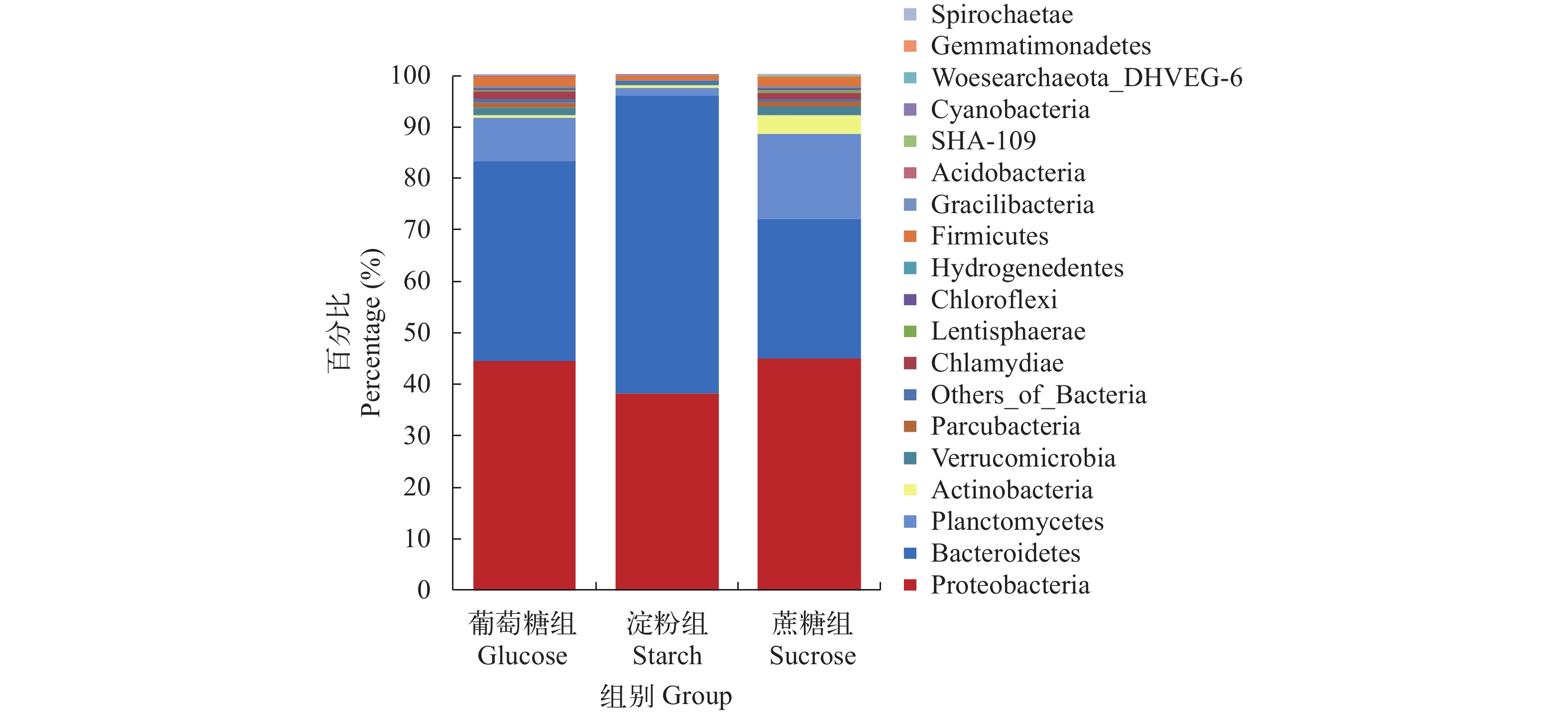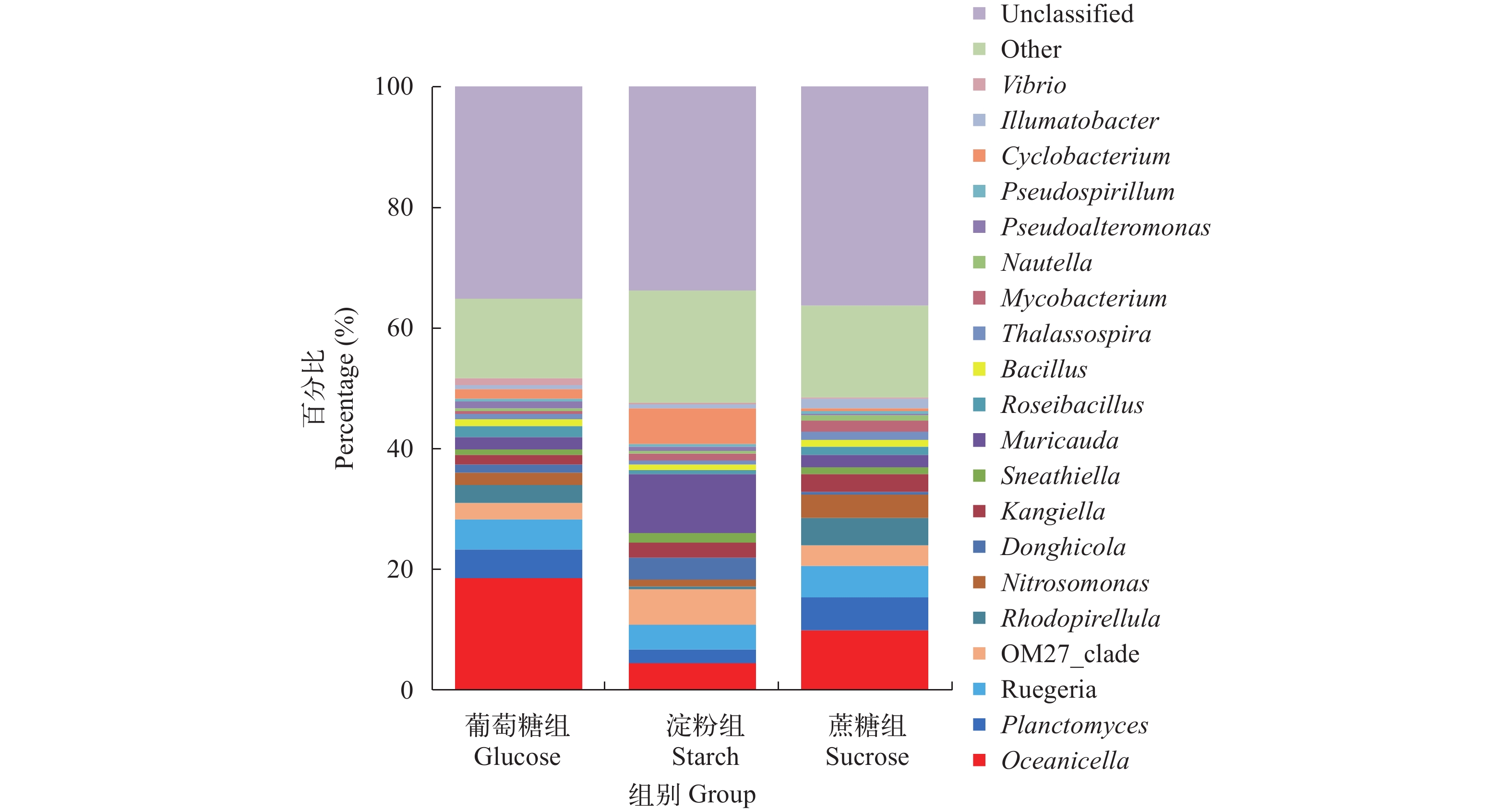IMPACTS OF LITOPENAEUS VANNAMEI ON MICROBIAL DIVERSITY OF THREE BIOFLOC AND PREDICTIVE ANALYSIS OF TAX4FUN GENE FUNCTION DURING HATCHERY PERIOD IN WATER
-
摘要: 为了解凡纳滨对虾(Litopenaeus vannamei)育苗期水体中3种生物絮团的形成过程、水质净化效果、菌群结构及功能, 实验通过测定各组絮团含量和水质指标并采用Illumina MiSeq高通量测序技术, 比较葡萄糖组、淀粉组和蔗糖组生物絮团的不同特征。结果显示, 各组形成的生物絮团可有效调节水质, 降低水体中的氨氮和亚硝酸盐氮水平。在3个碳源添加组水样中氨氮、亚硝酸盐氮和硝酸盐氮浓度显著低于对照组(P<0.05), 在不同碳源组中淀粉组的氨氮、亚硝酸盐氮和硝酸盐氮的浓度显著高于葡萄糖组和蔗糖组(P<0.05); 淀粉组的生物絮团沉降体积(BFV)显著低于葡萄糖组(P<0.05), 蔗糖组BFV最高, 3组粒径大小呈现: 蔗糖组>葡萄糖组>淀粉组; 3组样品分别测得553、515和542个OTU, 菌群丰度指数Chao1、Shannon值葡萄糖组>蔗糖组>淀粉组。各组菌群在门水平中, 以变形菌门(Proteobacteria)、拟杆菌门(Bacteroidetes)和浮霉菌门(Planctomycetes)为各组优势菌门, 3个菌门在各组中占比分别达到91.7%、97.6%和88.7%。在属级水平中, 葡萄糖组中Oceanicella属为优势菌属, 占比最高为18.4%, 淀粉组中丰度较高的Muricauda、Cyclobacterium属, 占比分别为9.8%和5.9%, 均高于葡萄糖组和蔗糖组。在蔗糖组中Rhodopirellula属具有较高占比, 较葡萄糖组和淀粉组分别高1.8%和4.1%。通过Tax4Fun法在3组中检测到细胞新陈代谢、遗传信息加工和环境信息处理等基因功能。这些功能基因在葡萄糖组中的丰度均高于蔗糖组和淀粉组。各项结果表明, 凡纳滨对虾育苗水体中生物絮团不仅可以净化水质, 还能提高水体菌群多样性, 其中以葡萄糖作为碳源效果最好, 生物絮团技术对于维持水质与水体生态系统平衡具有重要意义。Abstract: In order to explore the formation process, water purification effect, microbial structure and function of three types of biofloc in the water with Litopenaeus vannamei during hatchery period, the content of flocs and water quality index were measured, and Illumina MiSeq high-throughput sequencing technique was applied to compare the characte-ristics of biofloc in three groups with glucose, starch and sucrose, respectively. The results indicated that the biofloc formed in each group could effectively regulate water quality and reduce the levels of ammonia and nitrite. The concentrations of ammonia, nitrite and nitrate in the water samples from three experimental groups were significantly lower than those in the control group (P<0.05). The concentrations of ammonia, nitrite and nitrate in starch group were significantly higher than those in the glucose group and sucrose group (P<0.05). Moreover, the BFV in starch group was significantly lower than that in the glucose group (P<0.05), and the sucrose group possessed the highest BFV. The particle size of three groups was: sucrose group > glucose group > starch group. The quantity of 553, 515 and 542 OTUs was measured in the three groups respectively. Tthe microbial abundance index Chao1 and Shannon value implied the relationship in the three groups was: glucose group > sucrose group > starch group. Furthermore, regarding the phylum level, Proteobacteriae, Bacteroidetes and Planctomycetes were the dominant phylum in each group, and the proportion of three phylums in each group was 91.7%, 97.6% and 88.7%, respectively. However, in the genus level, Oceanicella was the dominant genus in glucose group, with the highest proportion of 18.4%, and the Muricauda and Cyclobacterium had the highest proportion in starch group, which were 9.8% and 5.9% respectively, and higher than those in glucose group and sucrose group. Rhodopirellula in sucrose group was 1.8% and 4.1% higher than that in the glucose group and starch group, respectively. Cell metabolism, genetic information processing and environmental information processing were detected in the three groups by Tax4Fun method. The gene function abundance in glucose group was higher than that in the sucrose and starch group. All of the results implied that biofloc in the breeding water with Litopenaeus vannamei could not only purify water quality, but also improve the microbial diversity, among which the glucose was the most effective carbon source. Nevertheless, biofloc technology is of essential to maintain the balance between water quality and water ecosystem.
-
-
表 1 添加不同碳源的生物絮团对水质指标的影响
Table 1 Effects of different carbohydrate sources on water quality
项目Item 葡萄糖组Glucose 淀粉组Starch 蔗糖组Sucrose 对照组Control 溶解氧DO (mg/L) 7.04±0.43a 7.53±0.26b 6.87±0.32a 7.82±0.28b pH 7.9±0.3a 7.7±0.2a 7.8±0.2a 8.0±0.2a 氨氮TAN (mg/L) 0.16±0.06a 0.25±0.06b 0.19±0.08a 0.42±0.13c 亚硝酸盐 ${\rm{NO}}_2^{-} $ -N (mg/L)
0.06±0.03a 0.15±0.03b 0.08±0.02a 0.26±0.06c 硝酸盐 ${\rm{NO}}_3^{-} $ -N (mg/L)
0.17±0.02a 0.72±0.04b 0.24±0.03a 1.13±0.12c 注: 结果均以平均值±标准误表示,表格中同一行不同字母表示有显著差异(P<0.05)Note: Each value represents mean±SD. Means with different letters in the same row mean significant differences (P<0.05) 表 2 三种生物絮团微生物群落多样性指数
Table 2 Bacterial diversity in three samples
组别
GroupObserved
species覆盖度
Coverage (%)Chao1 Shannon Simpson 葡萄糖组
Glucose553 99.9 594.6 6.13 0.893 淀粉组
Starch515 99.9 543.1 5.42 0.652 蔗糖组
Sucrose542 99.9 582.4 5.89 0.913 -
[1] 农业部渔业局. 2013中国渔业年鉴. 北京: 中国农业出版社. 2013, 165—210 Bureau of Fisheries of the Ministry of Agriculture. China Fishery Statistical Yearbook 2013 [M]. Beijing: China Agriculture Press. 2013, 165—210
[2] 刘杜娟, 潘晓艺, 尹文林, 等. 生物絮团在罗氏沼虾育苗中的应用. 上海海洋大学学报, 2013, 22(1): 47—53 Liu D J, Pan X Y, Yin W L, et al. Bio-flocs technology application in breeding of Macrobrachium rosenbergii [J]. Journal of Shanghai Ocean University, 2013, 22(1): 47—53
[3] Crab R, Kochva M, Verstraete W, et al. Bio-flocs technology application in over-wintering of tilapia [J]. Aquaculture Engineering, 2009, 40(2): 105—112
[4] 卢炳国, 王海英, 谢骏, 等. 不同C/N对草鱼池生物絮团的形成及水质的影响研究. 水产学报, 2013, 37(8): 1220—1228 Lu B G, Wang H Y, Xie J, et al. Effect of C/N ratio on bioflocs formation and water quality in zero-water exchange grass crap tanks [J]. Journal of Fisheries of China, 2013, 37(8): 1220—1228
[5] 李朝兵. 生物絮团作为鳙饵料的研究与应用. 硕士学位论文, 上海海洋大学, 上海. 2012 Li C B. The research and application of bioflocs as bait for bighead carp [D]. Thesis for Master of Science. Shanghai Ocean University, Shanghai. 2012
[6] Hollender J, van der Krol D, Kornberger L, et al. Effect of different carbon sources on the enhanced biological phosphorus removal in a sequencing batch reactor [J]. World Journal of Microbiology and Biotechnoloy, 2002, 18(4): 359—364 doi: 10.1023/A:1015258308460
[7] Oehmen A, Yuan Z, Blackall L L, Keller J. Short-term effects of carbon source on the competition of polyphosphate accumulating organisms and glycogen accumulating organisms [J]. Water Science and Technology, 2004, 50(10): 139—144 doi: 10.2166/wst.2004.0629
[8] Avnimelech Y, Schryver P D, Emmereciano M, et al. Biofloc Technology [M]. Baton Rouge: The World Aquaculture Society. 2012, 50, 146, 201
[9] 任利华, 李斌, 孙国华, 等. 16S rDNA 克隆文库解析仿刺参(Apostichopus japonicus)苗种培育池中生物絮团的细菌群落结构. 海洋与湖沼, 2015, 46(1): 197—205 Reng L H, Li B, Sun G H, et al. structure of bacterial community in biofloc from Apostichopus japonicus breeding ponds revealed by 16S rDNA clone library [J]. Oceanologia et Limnologia Sinica, 2015, 46(1): 197—205
[10] 夏磊, 赵明军, 张洪玉, 等. 不同比例复合益生菌对凡纳滨对虾生长、免疫及抗氨氮能力的影响. 中国水产科学, 2015, 22(6): 1299—1307 Xia L, Zhao M J, Zhang H Y, et al. Effects of different proportions of a group of compound bacteria on growth, innate immunity, and ammonia nitrogen resistance in Pacific white shrimp, Litopenaeus vannamei [J]. Journal of Fishery Sciences of China, 2015, 22(6): 1299—1307
[11] 李志华, 张玉蓉, 杨帆, 等. 除磷颗粒污泥系统中不同粒径颗粒的理化特性分析. 环境科学, 2012, 33(4): 1299—1305 Li Z H, Zhang Y R, Yang F, et al. Physicochemical cha-racteristics of granules with different size in a granular sludge system for phosphorus removal [J]. Environmen-tal Science, 2012, 33(4): 1299—1305
[12] 中华人民共和国国家质量监督检验检疫总局, 中国国家标准化管理委员会. GB17378. 4 -2007 海洋监测规范-第 4 部分: 海水分析. 北京: 中国标准出版社. 2008 State Bureau of Quality and Technical Supervision of China. The specification for marine monitoring Part 4: seawater analysis (GB 17378.4-2007) [S]. Beijing: China Standards Press. 2007
[13] Bokulich N A, Subramanian S, Faith J J, et al. Quality-filtering vastly improves diversity estimates from Illumina amplicon sequencing [J]. Nature Methods, 2013, 10(1): 57—59 doi: 10.1038/nmeth.2276
[14] Caporaso J G, Kuczynski J, Stombaugh J, et al. QIIME allows analysis of high-throughput community sequencing data [J]. Nature Methods, 2010, 7(5): 335—336 doi: 10.1038/nmeth.f.303
[15] Edgar, Robert C. UPARSE: highly accurate OTU sequences from microbial amplicon reads [J]. Nature Methods, 2013, 10(10): 996—998 doi: 10.1038/nmeth.2604
[16] Avnimelech Y. Biofloc Technology: a Practical Guide Book, second edition [M]. United States, Baton Rouge: The World Aquaculture Society. 2012, 189-195
[17] Van Wyk P, Scarpa J. Water quality requirements and management. In: Farming Marine Shrimp in Recirculating Freshwater Systems [M]. Tallahassee, FL, USA: Flori-da Department of Agriculture and Consumer Services, 1999, 141-162
[18] Hari B, Madhusoodana Kurup B, Varghese J T, et al. The effect of carbohydrate addition on water quality and the nitrogen budget in extensive shrimp culture systems [J]. Aquaculture, 2006, 252(2—4): 248—263 doi: 10.1016/j.aquaculture.2005.06.044
[19] 沈萍. 微生物学. 北京: 高等教育出版社. 2009, 151-152 Shen P. Microbiology [M]. Beijing: Advanced Education Press. 2009, 151-152
[20] Xu W J, Pan L Q, Sun X H, et al. Effects of bioflocs on water quality, and survival, growth and digestive enzyme activities of Litopenaeus vannamei (Boone) in zero-water exchange culture tanks [J]. Aquaculture Research, 2013, 44(7): 1093—1102 doi: 10.1111/are.2013.44.issue-7
[21] 夏耘, 郁二蒙, 谢骏, 等. 基于 PCR-DGGE 技术分析生物絮团的细菌群落结构. 水产学报, 2012, 36(10): 1563—1571 Xia Y, Yu E M, Xie J, et al. Analysis of bacterial community structure of Bio-Floc by PCR-DGGE [J]. Journal of Fisheries of China, 2012, 36(10): 1563—1571
[22] 吴智仁, 蒋素英, 周向同, 等. " 生物巢”形成及其水处理机制的理论分析. 环境保护前沿, 2016, 6(4): 61—68 Wu Z R, Jiang S Y, Zhou X T, et al. The theoretical analysis for the formation and wastewater treatment mecha-nism of " Bio-Nest” [J]. Advances in Environmental Protection, 2016, 6(4): 61—68
[23] 梅丽, 杨平, 郭勇. 厌氧-好氧一体化反应器固定化微生物处理茶多酚废水实验研究. 四川大学学报, 2007, 39(1): 83—87 doi: 10.3969/j.issn.1009-3087.2007.01.017 Mei L, Yang P, Guo Y. Study on the integrated anaero-bic-aerobic reactor of immobilized microbe to treat the tea polyphenols production wastewater [J]. Journal of Sichuan University, 2007, 39(1): 83—87 doi: 10.3969/j.issn.1009-3087.2007.01.017
[24] Huo Y Y, Li Z Y, You H, et al. Oceanicola antarcticus sp. nov. and Oceanicola flagellatus sp. nov., moderately halophilic bacteriaisolated from seawater [J]. Internatio-nal Journal of Systematic and Evolutionary Microbiology, 2014, 64: 2975—2979 doi: 10.1099/ijs.0.062588-0
[25] 王祖忠, 王朝阳, 张迪骏, 等. 宁波沿海陆源排污口弓形杆菌属(Arobacter sp.)和梭菌属(Clostri-dium sp.)的分布特点. 海洋与湖沼, 2016, 47(4): 862—868 Wang Z Z, Wang C Y, Zhang D J, et al. Arobacter and Clostridium distribution in sewage outlets along Ningbo coast [J]. Oceanologia et Limnologia Sinica, 2016, 47(4): 862—868
[26] Friedrich M, Springer N, Ludwig W, et al. Phylogenetic positions of Desulfofustis glycolicus gen. nov., sp. nov., and Syntrophobotulus glycolicus gen. nov., sp. nov., two new strict anaerobes growing with glycolic acid [J]. International Journal of Systematic Bacteriolog, 1996, (46): 1065—1069
[27] Christopher D.Ogg, Bharat K.C. Patel Thermotalea metallivorans gen. nov., sp. nov., a thermophilic, anaero-bic bacterium from the Great Artesian Basin of Australia aquifer [J]. International Journal of Systematic and Evolutionary Microbiology, 2009, 59: 964—971 doi: 10.1099/ijs.0.004218-0
[28] Xue M, Liang H F, He Y Y, et al. Characterization and in-vivo evaluation of potential probiotics of the bacterial flora within the water column of a healthy shrimp larviculture system [J]. Chinese Journal of Oceanology and Limnology, 2016, 34(3): 484—491 doi: 10.1007/s00343-016-5024-2
[29] Sakami T, Fujioka Y, Shimoda T. Comparison of microbial community structures in intensive and extensive shrimp culture ponds and a mangrove area in Thailand [J]. Fisheries Science, 2008, 74(4): 889—898 doi: 10.1111/fis.2008.74.issue-4
[30] Wagner M, Amann R, Lemmer H, et al. Probing activa-ted sludge with oligonucleotides specific for proteobacteria: inadequacy of culture-dependent methods for describing microbial community structure [J]. Applied and Environmental Microbiology, 1993, 59(5): 1520—1525
[31] Miura Y, Hiraiwa M N, Ito T, et al. Bacterial community structures in MBRs treating municipal wastewater: relationship between community stability and reactor performance [J]. Water Research, 2007, 41(3): 627—637 doi: 10.1016/j.watres.2006.11.005
[32] Daims H, Brühl A, Amann R, et al. The domain-specific probe EUB338 is insufficient for the detection of all bacteria: development and evaluation of a more comprehen-sive probe set [J]. Systematic and Applied Microbiology, 1999, 22(3): 434—444 doi: 10.1016/S0723-2020(99)80053-8
[33] Kirchman D L. The ecology of Cytophaga-Flavobacteria in aquatic environments [J]. FEMS Microbiology Ecology, 2002, 39(2): 91—100
[34] Nielsen P H, Mielczarek A T, Kragelund C, et al. A conceptual ecosystem model of microbial communities in enhanced biological phosphorus removal plants [J]. Water Research, 2010, 44(17): 5070—5088 doi: 10.1016/j.watres.2010.07.036
[35] Pujalte M J, Lucena T, Ruvira M A, et al. The Family Rhodobacteraceae [M]. Rosenberg E, DeLong E F, Lory S, et al. (Eds.), The Prokaryotes (4th edition), Alphaproteobacteria and Betaproteobacteria. Berlin: Springer. 2014, 439-512
[36] Cui Y W, Zhang H Y, Lu P F, et al. Effects of carbon sources on the enrichment of halophilic polyhydroxyalkanoate-storing mixed microbial culture in an aerobic dynamic feeding process [J]. Scientific Reports, 2016, 30766(6): 1—12
[37] Shu Q L, Jiao N Z. Different Planctomycetes diversity patterns in latitudinal surface seawater of the open sea and in sediment [J]. The Journal of Microbiology, 2008, 46(2): 154—159 doi: 10.1007/s12275-008-0002-9
[38] 黄佩蓓, 焦念志, 冯洁, 等. 海洋浮霉状菌多样性与生态学功能研究进展. 微生物学通报, 2014, 41(9): 1891—1902 Huang P B, Jiao N Z, Feng J, et al. Research progress on Planctomycetes diversity and ecological function in ma-rine environments [J]. Microbiology China, 2014, 41(9): 1891—1902
[39] Bauer M, Lombardot T, Teeling H, et al. Archaea-like genes for C-1-transfer enzymes in Planctomycetes: Phylogenetic implications of their unexpected presence in this phylum [J]. Journal of Molecular Evolution, 2004, 59(5): 571—586 doi: 10.1007/s00239-004-2643-6
[40] McCarren J, DeLong EF. Proteorhodopsin photosystem gene clusters exhibit co-evolutionary trends and shared ancestry among diverse marine microbial phyla [J]. Environmental Microbiology, 2007, 9(4): 846—858 doi: 10.1111/emi.2007.9.issue-4
[41] McBrideM J. The Family Flavobacteriaceae [M]. In: Rosenberg E, DeLong E F, Lory S (Eds.), The Prokaryotes (4th edition), other Major Lineages of Bacteria and the Archaea [M]. Berlin: Springer. 2014, 643—676
[42] Vandenberghe J, Verdonck L, Robles-Arozarena R, et al. Vibrios associated with Litopenaeus vannamei larvae, postlarvae, broodstock, and hatchery probionts [J]. Applied and Environmental Microbiology, 1999, 65(6): 2592—2597
[43] Soto-Rodríguez S A, Simoes N, Roque A, et al. Pathogenicity and colonization of Litopenaeus vannamei larvae by luminescent vibrios [J]. Aquaculture, 2006, 258(1—4): 109—115 doi: 10.1016/j.aquaculture.2006.04.035
[44] Blancheton J P, Attramadal K J K, Michaud L, et al. Insight into bacterial population in aquaculture systems and its implication [J]. Aquacultural Engineering, 2013, 53: 30—39 doi: 10.1016/j.aquaeng.2012.11.009
[45] 邓吉朋, 黄建华, 江世贵, 等. 生物絮团在斑节对虾养殖系统中的形成条件及作用效果. 南方水产, 2014, 10(3): 29—37 doi: 10.3969/j.issn.2095-0780.2014.03.005 Deng J P, Huang J H, Jiang S G, et al. Conditions for bio-floc formation and its effects on Penaeus monodon culture system [J]. South China Fisheries Science, 2014, 10(3): 29—37 doi: 10.3969/j.issn.2095-0780.2014.03.005
[46] 阮晓东. 活性污泥胞外聚合物的特征及去除污染物机制研究. 博士学位论文, 中国科学院研究生院, 北京. 2012 Ruan X D. Study on the characteristics and the contami-nants removal mechanism of extracellular polymeric substances from activated sludge [D]. Thesis for Doctor of Science. Graduate University of the Chinese Academy of Sciences, Beijing. 2012




 下载:
下载:





